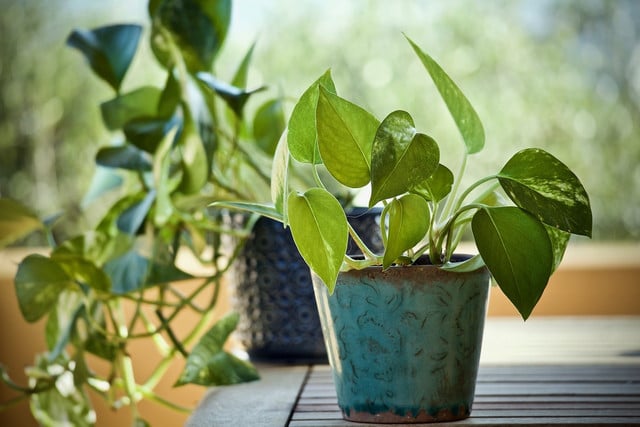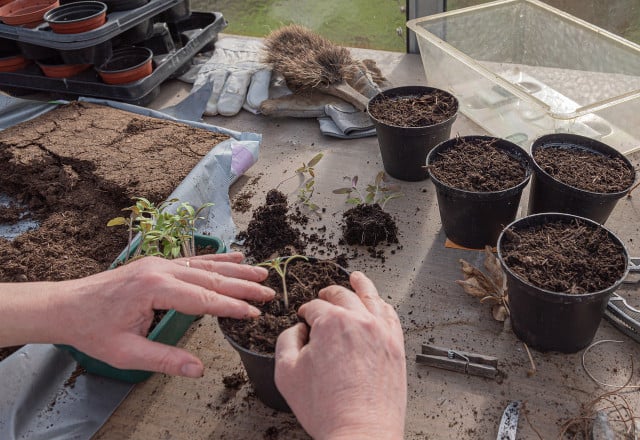The popular Pothos plant is a beautiful house plant known for being low-maintenance. However, even the best plant parents sometimes overwater Pothos. Follow our tips to keep your little guy healthy.
Epipremnum aureum, also known as the Pothos plant or ‘devil’s Ivy,’ is a common house plant known for its multicolored heart-shaped leaves. It’s typically used as an indoor hanging plant as the vines can grow long and wide to flow over the pot. Pothos plants are fairly easy to take care of as they prefer indirect sunlight and infrequent watering. However, overwatering Pothos plants is a common mistake.
Signs of an Overwatered Pothos

(Foto: CC0 / Pixabay / sweetlouise)
- Curled leaves are seen when a Pothos is overwatered. The leaves will curl downwards, in an effort to reduce surface area and slow down transpiration.
- Yellow or brown leaves are also a sign of overwatering. Discoloration can show up in spots or throughout the entire leaf.
- Mold is a definite sign your Pothos has been overwatered. Fungus needs a moist environment to grow and thrive, so if your plant’s soil is wet enough for mold, it’s been overwatered. You may not notice the mold initially, as it looks a bit like white powder. Moldy soil is a common but fixable problem in many house plants.
- Soft, limp leaves are a telltale sign. Your Pothos may also start losing leaves when overwatered.
- Wilting leaves indicate overwatered soil and possible root rot.
- Consistently wet soil. Pothos plants thrive in moist, but not soaking wet soil. You should always wait until the soil dries out a bit before watering again.
- Root rot is the worst case scenario as this will lead to the death of your Pothos. You can check by inspecting the soil. If the soil is loose and has a foul odor, you are probably dealing with root rot. Remove your plant from the soil and look at the roots. Root rot will make the Pothos roots brown, wet, mushy and stinky.
How to Fix an Overwatered Pothos



(Foto: CC0 / Pixabay / AndreasGoellner)
- Carefully remove the Pothos from the pot and brush away the soil.
- Check if the soil is smelly, wet, or moldy. If it is, make sure to dispose of the soil rather than saving it for future planting.
- Inspect the roots for root rot. Healthy roots should be firm and white. If the roots are dark and mushy, they are rotting.
- If there is no root rot and the soil is in good condition, simply return the plant back to its home and leave it alone to dry out over the next week or two. If the roots are rotting, they must be cut away. Using clean scissors, carefully cut away any roots which are brown, slimy or mushy. The remaining roots should be strong and light in color.
- Remove any dead leaves. Heavily drooping and discolored leaves must cut away so that your Pothos can direct its energy toward growing new, strong leaves and roots.
- Repot your Pothos in fresh, dry soil. Use a clean pot with many drainage holes. If you decide to stick with the same pot, make sure to clean it out with hot water and mild soap first.
- Leave your plant alone to recover from the trimming and repotting. Do not water it for at least a week.
Keeping Your Pothos Healthy



(Foto: CC0 / Pixabay / 5460160)
- Do not place your Pothos in direct sunlight. Pothos plants do well in lots of indirect light, however they can adapt to moderate and low light conditions as well.
- Water sparingly. Generally, Pothos plants only need to be watered every one to two weeks. In the summer, they will need a bit more frequent watering. Check if your Pothos needs watering by inserting your finger into the top inches of the soil. The top two inches should be dry before you water the plant. If they are still a bit moist, wait a few more days before watering.
- Use a pot with many drainage holes and place a saucer underneath. This is imperative to your plant’s health. The Pothos must be able to get rid of excess water. Using a saucer is great not only for clean-up, but to help you gauge how much water your plant really needs. Once the water starts flowing into the saucer, you know you’re done for the day. Make sure to throw out the excess water within ten minutes of watering, otherwise your plant will get root rot.
- Open windows to provide fresh air and ventilation. This helps to prevent overwatering.
- Place your Pothos in a humid environment, if possible. One of the ways people tend to overwater Pothos plants is through attempting to imitate humidity. Instead of extra watering, try to emulate humidity by keeping your plant in the bathroom, or misting its leaves occasionally.
Read more
- Keep Your Houseplants Alive: 10 Tips for Healthy Indoor Plants
- 7 Signs Of Overwatering Plants & What to Do
- Homemade Plant Food: Tips for Helping Wilted Plant
Do you like this post?
17
0
Thank you very much for voting!






